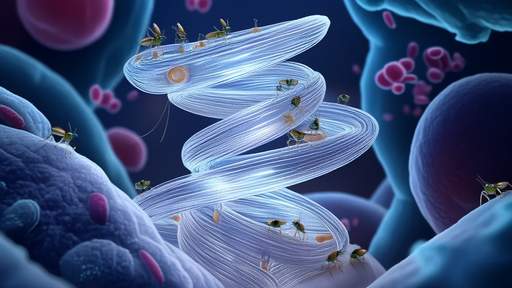Nature often provides an escape from the chaos of urban life, but sometimes, the most fascinating stories are hidden right beneath our feet. In the quiet shade of a fruit tree, a remarkable phenomenon unfolds that challenges our understanding of the microscopic world. Tiny worms, known as nematodes, are constructing miniature skyscrapers, not from steel or concrete, but from their own wriggling bodies. These microscopic architects, found all over the Earth's surface, have recently revealed their incredible building techniques to scientists in Germany. This discovery is not just a marvel of nature but also a window into the complex social behaviors of some of the smallest creatures on our planet.
The Discovery of Nematode Towers
Researchers from the Max Planck Institute of Animal Behavior and the University of Konstanz have made a groundbreaking observation. After months of meticulously examining rotten pears and apples in local orchards, they spotted hundreds of 1-millimeter-long nematodes, specifically Caenorhabditis elegans, climbing onto each other and forming structures up to 10 times their individual size. These tiny worms, often overlooked due to their microscopic size, were amassing into vertical towers, a behavior never before witnessed in nature.
The Laboratory Investigation
To delve deeper into the mysterious physics and motivations behind these soft, slimy towers, the study team brought samples of Caenorhabditis elegans into the lab. There, they observed that the worms could assemble into towers within hours. Some worms even extended out from the mass as exploratory "arms," sensing the environment and building accordingly. But the question remained: Why were these worms forming such structures?
The Evolutionary Purpose of Nematode Towers
The findings, published in the journal *Current Biology*, suggest that these tiny worms are not just randomly stacking on top of each other. According to senior study author Serena Ding, a research group leader at the Max Planck Institute, "It’s a coordinated superorganism, acting and moving as a whole." The team tested the worms' reactions to various stimuli while they were stacked in a tower formation. They discovered that the worms were highly reactive to external stimuli, such as being poked, prodded, or even visited by a fly. The towers would move towards these stimuli, attaching themselves to objects or even flying insects.
The Motivation Behind the Towers
The coordinated reaction of the nematodes suggests that they are forming these structures to hitch a ride on larger animals, such as insects, to transport them to new locations with more food. As first author Daniela Perez explained, "An animal that is 1 millimeter long cannot just crawl all the way to the next fruit 2 meters away. It could easily die on the way there, or be eaten by a predator." By forming a tower, the nematodes can collectively reach a larger animal and use it as a means of transportation to new sources of food. This behavior not only ensures their survival but also allows them to continue reproducing in new environments.
The Social Dynamics of Nematodes
The discovery of these towers raises intriguing questions about the social behaviors of nematodes. Are these worms cooperating to help each other, or is their behavior more competitive? Studying the behaviors of other self-assembling creatures, such as ants, could offer valuable insights. Ants, known for their cooperative nature, assemble to form buoyant rafts to survive floodwaters. Like ants, nematodes did not display any obvious role differentiation or hierarchy within the tower structures. Each worm, from the base to the top, was equally mobile and strong, indicating that competition was not a factor.
The Role of Communication
Understanding how nematodes communicate within these structures is another crucial area of research. While ants use pheromone trails, honeybees rely on dance routines, and slime molds use chemical signals, the communication methods of nematodes remain a mystery. Further studies are needed to determine if and how these worms coordinate their actions within the tower structures.
Future Research and Applications
The next steps for the research team involve exploring whether the formation of these structures is a cooperative or competitive behavior. Studying other self-assembling creatures could provide clues to the social norms of nematodes. Additionally, understanding the communication methods of these tiny worms could have broader implications. For instance, insights into the complex sociality of nematodes could inform how technology, such as computer servers or drone systems, communicates in the future.
The discovery of nematode towers is a testament to the incredible adaptability and social behaviors of some of the smallest creatures on Earth. These microscopic worms, once thought to be simple organisms, are revealing complex behaviors that challenge our understanding of the natural world. By studying the motivations and mechanisms behind their tower-building, scientists can gain valuable insights into the evolutionary purpose of social behaviors and the ways in which even the smallest animals can work together to achieve common goals.
As researchers continue to explore the microscopic world, the story of nematodes and their towering achievements serves as a reminder that even the tiniest creatures can have a significant impact. Their ability to form coordinated structures and adapt to their environment offers a fascinating glimpse into the intricate social dynamics of life on Earth.

By Daniel Scott/Jun 6, 2025

By John Smith/Jun 6, 2025

By Daniel Scott/Jun 6, 2025

By Emma Thompson/Jun 6, 2025

By Sophia Lewis/Jun 6, 2025

By Olivia Reed/Jun 6, 2025

By Joshua Howard/Jun 6, 2025

By David Anderson/Jun 6, 2025

By Emma Thompson/Jun 6, 2025

By Emily Johnson/Jun 6, 2025

By Samuel Cooper/Jun 6, 2025

By Emily Johnson/Jun 6, 2025

By Sophia Lewis/Jun 6, 2025

By Jessica Lee/Jun 6, 2025